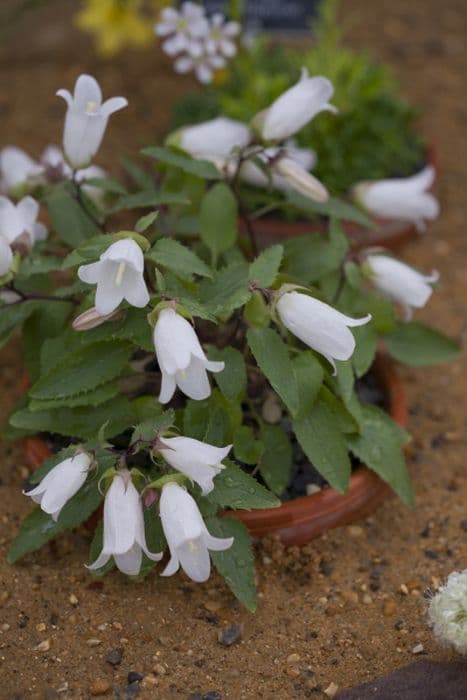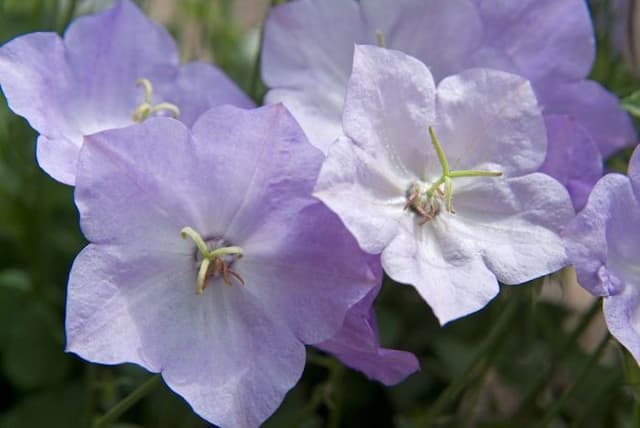Blue Star Creeper Isotoma axillaris Fizz 'n' Pop Glowing Purple = 'Tmlu 1301'
![blue star creeper [Fizz 'n' Pop Glowing Purple]](/_next/image?url=https%3A%2F%2Fplants-admin.emdemapps.com%2Fimages%2Fplants%2F%2Fimages%2F604b54154ccf1.png&w=3840&q=75)
ABOUT
Isotoma axillaris Fizz 'n' Pop Glowing Purple, commonly known as the Blue Star Creeper, boasts an eye-catching appearance that is highlighted by its vibrant violet and purple flowers. These flowers exhibit a flamboyant display, presenting themselves prominently above the foliage. The petals present a star-like shape, contributing to its common name, and create a striking visual effect that is further amplified by their glowing hues. The foliage of the Blue Star Creeper is equally attractive, with lush green leaves providing a dense, mounding backdrop for the spectacular blossoms. The leaves are small and delicate, adding to the plant's overall soft and fine-textured appearance. This dense foliage creates a full, verdant spread that acts as a superb canvas for the glowing purple flowers, ensuring that they stand out with an almost luminous quality. The Blue Star Creeper's overall aesthetic is one of bright, intense color contrasted with greenery, a feature that makes it a popular choice for gardeners looking to add a splash of color to their landscapes. While this plant is beloved for its ornamental value, it is also appreciated for its resilience and adaptability, making it an excellent ground cover option for various garden settings.
About this plant
 Names
NamesFamily
Lobeliaceae
Synonyms
Rock Isotome, Blue Star Flower
Common names
Isotoma axillaris 'Tmlu 1301'
 Toxicity
ToxicityTo humans
The toxicity of the Blue Star Creeper to humans is generally considered to be low. Ingesting any part of the plant may lead to mild gastrointestinal discomfort, but it is not known to have any severe toxic effects. Nonetheless, it is advisable to avoid consuming this plant.
To pets
The toxicity of the Blue Star Creeper to pets, such as dogs and cats, is also low. Similar to humans, if pets ingest parts of this plant, they might suffer from minor digestive upsets, but significant toxicity is unusual. However, it is always best to prevent pets from eating plants not intended for consumption.
 Characteristics
CharacteristicsLife cycle
Perennials
Foliage type
Evergreen
Color of leaves
Green
Flower color
Purple
Height
2 feet (0.61 meters)
Spread
2 feet (0.61 meters)
Plant type
Herb
Hardiness zones
9
Native area
Australia
Benefits
 General Benefits
General Benefits- Attracts pollinators: Isotoma axillaris Fizz 'n' Pop Glowing Purple is known to attract bees and butterflies, which are beneficial for pollination in the garden.
- Low maintenance: This variety of Rock Isotome typically requires minimal care once established, making it a great addition for gardeners of all skill levels.
- Drought-tolerant: After it is established, this plant can tolerate periods of dryness, making it suitable for xeriscaping or areas with water restrictions.
- Long blooming season: Rock Isotome provides a long season of vibrant purple blooms, which can enhance the overall aesthetic of a garden or landscape.
- Compact growth: Its compact growth habit makes it suitable for containers, borders, and small garden spaces where it can provide color and texture without overwhelming the area.
- Deer resistant: The plant is often resistant to deer, which makes it an excellent choice for gardens in areas where deer browsing can be a problem.
- Versatile use: Rock Isotome can be used in rock gardens, as a groundcover, or as part of a mixed perennial bed, offering versatility in garden design.
 Medical Properties
Medical PropertiesThis plant is not used for medical purposes.
 Air-purifying Qualities
Air-purifying QualitiesThis plant is not specifically known for air purifying qualities.
 Other Uses
Other Uses- Floral Art: The vibrant flowers of Isotoma axillaris can be used to create stunning and colorful floral arrangements.
- Photography Backdrop: The intense purple blossoms make an excellent backdrop for photographers looking to add a pop of color to their imagery.
- Educational Tool: Horticulture schools and universities might use the plant to teach students about plant propagation and breeding programs.
- Event Decoration: Live plants or cut flowers of Isotoma can be used to adorn event spaces, providing a natural and refreshing look.
- Natural Dye: The petals could potentially be used to produce a natural purple dye for fabrics or crafts, although this is not a common practice.
- Stress Relief: Gardening with Isotoma axillaris may offer a soothing activity that can help reduce stress and promote relaxation.
- Theme Gardens: This plant can be incorporated into themed gardens, such as 'purple gardens' or 'moon gardens' where it blooms in the evening.
- Fauna Attraction: Isotoma can attract beneficial insects like bees or butterflies, supporting biodiversity in the garden.
- Seasonal Celebrations: Specific floral colors can be used in festivities or religious ceremonies, and Isotoma's flowers might be included based on their color and seasonality.
- Garden Borders: The compact growth habit of Isotoma makes it suitable for creating vivid edges and borders in landscape designs.
Interesting Facts
 Feng Shui
Feng ShuiThe Blue Star Creeper is not used in Feng Shui practice.
 Zodiac Sign Compitability
Zodiac Sign CompitabilityThe Blue Star Creeper is not used in astrology practice.
 Plant Symbolism
Plant SymbolismUnfortunately, there are no specific symbolic meanings associated with Isotoma axillaris Fizz 'n' Pop Glowing Purple, as it doesn't have a long cultural history or widespread recognition that would lend itself to symbolic interpretation. This plant may be appreciated for its aesthetic qualities rather than its symbolism.
 Water
WaterBlue star creeper, which is a common name for Isotoma axillaris 'Fizz 'n' Pop Glowing Purple', prefers consistently moist but not soggy soil. Water this plant when the top inch of soil feels dry to the touch. Typically, this may mean watering once or twice a week, depending on climate conditions. Use a watering can or hose to gently water at the base of the plant, avoiding wetting the foliage. Generally, a total of around one gallon per week should be sufficient during the growing season, but less water may be needed during cooler months when the plant is not actively growing.
 Light
LightBlue star creeper thrives in full sun to partial shade conditions. Place the plant in a spot where it will receive at least six hours of sunlight a day for optimum growth and flowering. While it can tolerate some shade, too little light may result in leggy growth and fewer flowers. Avoiding deep shade is crucial for maintaining the plant’s vibrant color and compact form.
 Temperature
TemperatureThe blue star creeper can tolerate a range of temperatures but performs best in environments where temperatures are between 60°F and 80°F. It is hardy in USDA zones 6 to 9 and can survive minimum temperatures down to around -10°F. During exceptionally cold snaps, it's advisable to provide some protection such as mulch to minimize damage to the root system.
 Pruning
PruningPrune blue star creeper to maintain a neat appearance and encourage dense, bushy growth. Trimming lightly after the main flowering flush has finished can stimulate a second bloom. Typically, this plant may be pruned in late spring or early summer. Cut back any dead or damaged stems anytime they appear to keep the plant healthy.
 Cleaning
CleaningAs needed
 Soil
SoilThe Blue Star Creeper requires well-draining soil with a peat moss or compost base, mixed with perlite or pumice for extra drainage. A slightly acidic to neutral pH of 6.0 to 7.0 is ideal for optimal growth.
 Repotting
RepottingBlue Star Creeper should be repotted every 1-2 years to refresh the soil and accommodate root growth, ideally during spring or early summer.
 Humidity & Misting
Humidity & MistingBlue Star Creeper thrives in moderate to high humidity levels, around 50-70%. Avoid environments that are too dry for this plant to maintain its health.
 Suitable locations
Suitable locationsIndoor
Bright indirect light, high humidity, and well-draining soil.
Outdoor
Full sun to partial shade, well-draining soil, protect in freezing temps.
Hardiness zone
6-9 USDA
 Life cycle
Life cycleIsotoma axillaris Fizz 'n' Pop Glowing Purple, commonly known as Blue Star, begins its life as a seed which germinates when conditions are right, usually involving moist, well-draining soil and warm temperatures. After germination, the seedling emerges and establishes itself, developing a root system and foliage through photosynthesis. As the Blue Star matures, it enters a vegetative growth phase, during which it produces more substantial foliage and begins to form its characteristic star-shaped flowers. Following pollination, which is often aided by insects attracted to the vibrant blooms, the plant sets seed, completing the reproductive stage. These seeds (once mature) are dispersed from the parent plant to begin a new life cycle. The Blue Star is a perennial, so it also enters a dormant phase during colder climates, ceasing active growth and reserving energy in its root system to survive until the conditions are favorable again for resuming growth.
 Propogation
PropogationPropogation time
Spring to Summer
Propogation: The most popular method of propagating the Blue Star Creeper, Isotoma axillaris Fizz 'n' Pop Glowing Purple, is through division. This method can be carried out in early spring or fall when the plant's growth is not at its peak. To propagate by division, gently dig up the plant, making sure to keep a good amount of soil around the roots. Using your hands or a sharp knife, divide the plant into smaller sections, ensuring that each section has a portion of the root system attached. Replant the divisions immediately at the same depth they were originally growing, watering them well after planting. This process will enable the divisions to establish their own roots, growing into full plants over time. It is important to maintain consistent moisture and provide light shade until new growth indicates that the division has taken root.









![Milky bellflower [Avalanche]](/_next/image?url=https%3A%2F%2Fplants-admin.emdemapps.com%2Fimages%2Fplants%2F%2Fimages%2F604b5dc88c1e7.png&w=640&q=75)